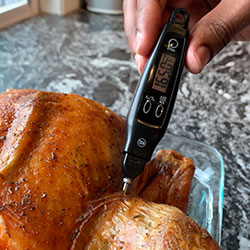
Follow the guidelines below for how to cook raw meat, poultry, seafood, and other foods to a safe minimum internal temperature. Always use a food thermometer to check whether meat has reached a safe minimum internal temperature that is hot enough to kill harmful germs that cause food poisoning.
Some meats also need rest time after cooking. Rest time is important for certain meats because it allows the innermost parts and juices of the meats to become fully and safely cooked.
Safe Minimum Internal Temperature Chart for Cooking
Print Food Temperature Chart or Download as PDF| Food | Type | Internal Temperature (°F/°C) |
|---|---|---|
| Beef, bison, veal, goat, and lamb | Steaks, roasts, chops | 145°F (63°C) Rest time: 3 minutes |
| Ground meat and sausage | 160°F (71°C) | |
| Casseroles | Meat and meatless | 165°F (74°C) |
| Chicken, turkey, and other poultry | All: whole bird, breasts, legs, thighs, wings, ground poultry, giblets, sausage, and stuffing inside poultry. See USDA's Turkey Thawing Calculator and Turkey Cooking Calculator. | 165°F (74°C) |
| Eggs | Raw eggs | Cook until yolk and white are firm |
| Egg dishes (such as frittata, quiche) | 160°F (71°C) | |
| Casseroles (containing meat and poultry) | 165°F (74°C) | |
| Ham | Raw ham | 145°F (63°C) Rest time: 3 minutes |
| Precooked ham (to reheat) | 165°F (74°C) Note: Reheat cooked hams packaged in USDA-inspected plants to 140°F (60°C) | |
| Leftovers | Any type | 165°F (74°C) |
| Pork | Steaks, roasts, chops | 145°F (63°C) Rest time: 3 minutes |
| Ground meat and sausage | 160°F (71°C) | |
| Rabbit and venison | Wild or farm-raised | 160°F (71°C) |
| Seafood | Fish (whole or filet), such as salmon, tuna, tilapia, pollock, bass, cod, catfish, trout, etc. | 145°F (63°C) or cook until flesh is no longer translucent and separates easily with a fork |
| Shrimp, lobster, crab, and scallops | Cook until flesh is pearly or white, and opaque | |
| Clams, oysters, mussels | Cook until shells open during cooking |

